#pbs.org/activate
Explore tagged Tumblr posts
Text

The Melancholic Woman: Eva Hesse, Ennead (1965), and Trauma, De-strung


(source: ICA Boston)
I will open this essay with a line from art historian, Anne M. Wagner’s essay, Another Hesse, on her journal October, vol. 69 – wherein she writes of our subject, American sculptor Eva Hesse:
Hesse’s self-scrutiny, we learn once again, is a means of coping with “environment” – with the inheritance of the past. But it is also the measure – even the proud badge – of her “difference”, the difference, we remember, of being an artist. (p. 131)
Anne M. Wagner’s essay on Eva Hesse will be one of the main sources of this paper.
Here, we will be able to trace Eva Hesse’s art and its asymbolia to the artist’s melancholia and her journey of sublimation and working through. We will also thereby arrive at more questions to ponder Hesse’s life, and inquire about the connections among art, melancholia, and the semiotic – and possibly ponder a perspective that ties the end-goal of these Kristevan concepts together.
(Before I go on, I just wanna say that this essay may draw on similarities EVA HESSE: POST-MINIMALISM INTO SUBLIME, by Robert Pincus-Witten. I wrote this specific essay more than a year ago for my Cultural, Literary, and Critical Theory class, and I only found this essay just today, as I am writing and doing more research for this piece. LOL. However, I would like to justify that the content of my essay is to draw connections between Hesse’s art and Kristeva’s psychoanalytic theory. I did enjoy Witten’s essay, though!)

(Source: pbs.org)
Eva Hesse
At the height of Nazi Germany, Hesse’s family fled to America for protection from religious persecution, but it was not long until sanctuary proved to be fickle as well, in the land of the free. Due to trauma implicated by the Second World War that vehemently caused the deaths of Hesse’s extended family, the serious circumstances of (Eva Hesse’s mother) Ruth Marcus House’s bipolar disorder worsened. These events dominoed to Wilhelm Hesse’s divorce from Ruth Marcus, and Ruth’s suicide. Adding salt to the wound, Wilhelm would marry a woman named Eva. Upon the new marriage, the young girl and her step-mother would share the same name.
Identity crisis aggravated young Eva’s trauma – from the persecution of family whose faces she had never known, to losing her to suicidal mother at ten. It seemed like grief was her very being.
Graduating from Yale, she exhibited works whose style displayed that of Abstract Expressionism and paved the way for Minimalism.
Art historians speculate how these traumas were sublimated into her art. Her self-portraits showcase distorted images of faces and figures. They are almost like a child’s attempt at creating a figure painting, except that their tone is so somber that only an adult can express such a feeling.

(Untitled, 1965, oil on canvas: From: mutualart.com)
However, the most intriguing work of Hesse does not come from two-dimensions – but three. This includes Hesse’s sculpture, Ennead (1965).


(Ennead, 1965, oil on canvas. From: icaboston.org)
Eva Hesse’s Ennead (1965)
All that there is to the piece: acrylic, paper mache, some resin-coated strings, plywood, some plastic, and a title possibly referencing the Egyptian pantheon.
The Institute of Contemporary Art, Boston, describes the artwork as such:
The orderly, formulaic application of the threads devolves into an increasingly chaotic composition as they accumulate and tangle toward the floor. A few strands are affixed to the adjacent wall, cordoning off a wedge of space that becomes part of the sculpture itself. This gesture also draws the viewer’s attention to the corner of the gallery, activating this normally overlooked area. Additional material hangs to touch the floor, thus uniting three planes. “Ennead” means a group of nine, in this case referring to the nine points from which the strings extend.
How can we interpret art whose surface presence is devoid of any points from its meaning? Baroque art can be so interpreted by its gargantuan number of details that fit on a four-cornered canvas. Poetry can be dissected among its metaphors, language, and enjambments. How can we possibly describe a sculpture so bare of material and overly abstract in its form? Was it meant to be this way – stripped down and bare?
Asymbolia and Melancholia
Many of Hesse’s works portray a distinct use of asymbolia, and the stimulation of asymbolia to its audience.
It is impossible to speak of Ennead without speaking about Hesse – primarily because Hesse and her art are one. Hesse even says: “My life and art have not been separated. They have been together.”
Ennead is no exception – however, with absolutely little to no “initial and final'' interpretation of meaning when you see the sculpture. What can we then say about Eva Hesse through the piece? Even art historians themselves, up to this day, consider Ennead to be an enigma on its own – its minimalism minimizes itself, to the point of devoiding any meaning, making us doubt if there is any at all.
First, we must discuss the asymbolia in Ennead – the art itself. Though by instinct and intuition, the substance of Ennead is uninhabited on its own, I would like to shed a few pointers on the piece and its asymbolia through its deliberate absurdity.
The strings were meant to be orderly at first, until its tail-end, wherein Hesse describes them as a jungle. Hesse even took in the effort to dye the strings to possibly add more aesthetic depth to them. Hesse describes the process of this piece in one of her journals.
The further it went toward the ground, the more chaotic it got; the further you got from the structure, the more it varied. I've always opposed content to form or just form to form. (Quoted in L. R. Lippard, op. cit., p. 62)
However, even when Hesse describes her decision to irrationalize the hinds of the strings, the art still talks gravel to the path towards the most inane question: What does it mean?
So, we shall secondly address the audience’s confusion, that stems from the asymbolia of the audience themselves – the very inability to attach any familiarity or meaning to the symbols the art presents, because of the very fact that it lacks anything.
The only thing that makes sense of Hesse’s art is nonsense – the asymbolia found in Hesse’s art, that stems from dissecting, stripping down, and representing her trauma. Hesse states in one of her interviews: “There is no abstract art. You must always start with something… A painter paints to unload himself of feelings and vision.”
Must her own “something” be from her depression – from the trauma of losing her mother, identity, and other factors throughout?
We take the theory behind this inquiry from Julia Kristeva’s illustration of asymbolia and melancholia in her book, Black Sun – “The negation of that fundamental loss opens up the realm of signs for us, but the mourning is often incomplete. Melancholia then ends up in asymbolia, in loss of meaning…” (p.42).
Hence, to study the bare Ennead is to study Hesse’s bare melancholia.
We may never have the opportunity to bear witness to Hesse’s trauma, as only she and herself can live it, so we turn to her journals,
Throughout her life, Hesse seems to be on good terms with working through with her depression, as she sublimates it with her art – if it means going against the conventions imposed on her by four-cornered dimensions of papers and canvases, and the one-platform norm of past sculptures (Ennead takes up two adjacent walls, and thereby two dimensions).
Asymbolia and the neglect of the pre-conceived semiotic can be seen in her journals – which instead of letters and intelligible words, consist of drawings that penetrate any dividers and lines.
Kristeva furthermore explains this psychoanalytic mechanism as she illustrates the control of the preverbal in aesthetic creation: “When the struggle between imaginary creation (art, literature) and depression is carried out precisely on that frontier of the symbolic and the biological we see indeed that the narrative or the argument is ruled by primary processes” (p.65) – explaining the subnormality of Hesse’s art and entries, and how the manifestations of obscurity stem from the mere struggle of Hesse’s melancholia.

(Figure 3: Hesse’s journal. From: sugarcandymtn.com)
Other than these, her excerpts write of her own feelings of depression and anxiety: “I must write, my sanity is involved. I cry and cry, the pages are wet. I have no one, to go to and the edge of hysteria and insanity is not far apart” (October 19, 1964).
Anne M. Wagner writes: “Anyone who wants to make a serious contribution to remembering Hesse will likewise have to speak about a wound. For what is striking about Hesse’s art is its utter inwardness, with artistic languages of the day: her imagery and effects are not learned by rote, only to be parroted back more or less unchanged” (p. 159)
With this: Must her melancholia still be the root of her asymbolic art? Or was this art a testament to her ability to self-scrutinize all along? Furthermore, will there be anything to self-scrutinize when there is no trauma?
Conclusion: The Futile Point of Interpretation
Hesse intended her work to be autobiographical, but never understood – and thus reflecting the paradox of identity: to know, but never understand. Even her journals were not meant for the purpose of understanding: “Hesse’s journals and their users have meant that it is no longer possible for viewers “not to know the artist” – or at least, not to feel they know her, and to prepare themselves accordingly when looking at her art.”
Yet, even when we have read Hesse’s journals, watched documentaries, and studied countless journals from art historians – the impossibility to fully understand still looms over her audience. So then we ask the question: What should we feel to know of Hesse? The illness caused by both personal and socio-economic circumstances of her time? Must her works be cursed with the fallacy of perpetually being tied to her trauma.
On Dostoevsky, Kristeva writes: “Works of art thus lead us to establish relations with ourselves and others that are less destructive, more soothing.” Hesse’s artifacts are therefore not records of her mania, but documentations of her survival from it. Her illness, therefore, is not what should be reflected of her life – but her sisyphean triumph over it.
Maybe it is for the better – as the point of art itself is to sublimate the traumatic aggression of the artist, and (like a monster) to never let it out of the cage of the canvas. Kristeva can even attest to this, saying: “Art seems to point to a few devices that bypass complacency and, without simply turning mourning into mania, secure for the artist the connoisseur a sublimatory hold over the lost Thing” (p. 97)
Hesse did this concealment well, so much so that it is said the artist herself might not have realized this. As Wagner would write: “If Hesse’s life did enter her art, it did so by a process that Hesse herself was in a position to describe. We would be looking for ways (Hesse’s unconscious) repeatedly configured. I think such imagery exists in Hesse’s art, and I take it to concern the artist’s feelings toward her mother above all” (p. 165) So much so, that even daring to question the trauma behind Hesse’s art, we do not only turn a blind eye to the artist herself, but arrive at a futile destination when we do: “Yet, in asking them [questions on Hesse’s art] we risk losing sight of the workings of Hesse’s unconscious – a notion that, after all, was the motivating impulse of this discussion. But the artist and her unconscious are not far away.” (p. 173)
Conclusion
I will close with another one of Wagner’s concluding lines:
“To claim that Hesse’s art aims to remember and express a common human quality or experience is not the same as attributing to it some universal force or purpose. It gives its own account of that experience.” (p. 186)
This aim of art is reminiscent to how beauty sublimates melancholia in the form of art, much like giving its own account of an experience. Kristeva writes:
“Beauty emerges as the admirable face of loss, transforming it in order to make it live. Melancholia to the point of becoming interested in the life of signs, beauty may also grab hold of us to bear witness for someone who grandly discovered the royal way through which humanity transcends the grief of being apart.”
(p. 100)
Hesse’s journey as an artist is proof that asymbolia – another result of melancholia – paves the way into sublimation. Art is therefore not rooted in the melancholic, its her way of forging a path deeper underneath it. Art is agency from the trial of inner-disagency. Art is therefore the artist’s most individual and subjective struggle, not of her depression, but one of working through. Precisely through this art, we unlock the beauty sculpted from the marble of melancholia. Hesse and Ennead are just among the myriad of melancholic beauty in the realm of art.
SOURCES
Kristeva Julia. Black Sun : Depression and Melancholia. Columbia University Press 1989. https://archive.org/details/blacksun00juli. Accessed 27 Feb. 2023.
Artincontext. “Eva Hesse - The Brief Life and Incredible Works of Eva Hesse the Artist.” Artincontext.org, 4 Apr. 2022, https://artincontext.org/eva-hesse/.
Branaman, Bianca. “Love - Eva Hesse.” Sugar Candy Mountain, Sugar Candy Mountain, 4 Sept. 2018, https://sugarcandymtn.com/blogs/the-brand/love-eva-hesse.
“Ennead.” EVA HESSE, https://www.christies.com/en/lot/lot-315751.
“Ennead.” Institute of Contemporary Art, Boston, https://www.icaboston.org/art/eva-hesse/ennead.
Evemy, Benjamin Blake, et al. “Auctions, Exhibitions & Analysis for +500K Artists.” MutualArt, MutualArt, 17 Feb. 2023, https://www.mutualart.com/.
“The Sickness of Being Disallowed: Premonition and Insight in the 'Artist's Sketchbook'.” O A R, https://www.oarplatform.com/sickness-disallowed-premonition-insight-artists-sketchbook/.
#antiquities#literary theory#psychoanalysis#literature#art#history#art history#art criticism#art critique#fine art#museum studies#postmodernism#modernism#julia kristeva#sigmund freud#culture#society#culturalheritage#eva hesse#female artists#female artwork#trauma#abstract#post minimalism#minimalism#minimalist art#post minimalist art
15 notes
·
View notes
Text
Around Town with Cyberchase (and The Harry Show)
Hello all,
I wanted to talk about another promotional area of the Cyberchase website. This was "Around Town with Cyberchase". I believe it was active from 2009 through 2010.
Here is the main page, featuring Harry with his binoculars.

The purpose of this section was two-fold. I'll let Harry explain in this promo video, which was probably exclusive to the website.
So, there were two parts to this promotion. On the one hand, we have preview clips for upcoming episodes of the Cyberchase cartoon. These were presented on top of webpage backgrounds, and most of the webpage backgrounds had flash animations related to the episodes. I cannot reproduce the animation here, but I have submitted them for inclusion in the Flashpoint Archive Project.
The main page for the Cyberchase cartoon episode previews has an animation of Jackie painting the Hedgehoppers in Pompodouria during Season 7 Episode 7 "Spellbound".
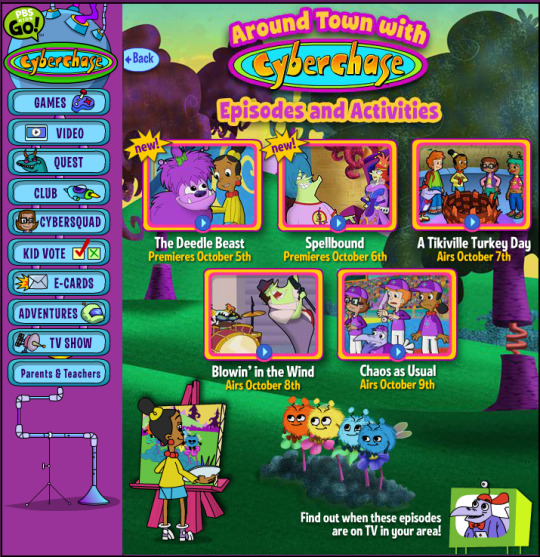
The page for Season 7 Episode 6 "The Deedle Beast" had an animation of the kids arriving in Golftopia to help Digit with Dewey the Deedle Beast.
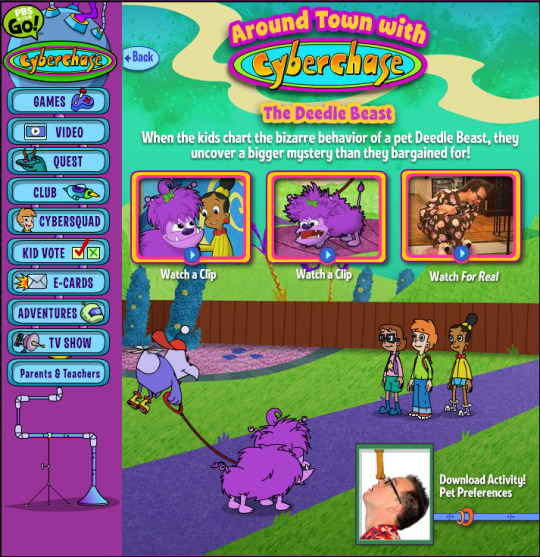
The page for Season 7 Episode 7 "Spellbound" featured an animation of Wicked flying around on her broom.

The page for Season 4 Episode 10 "A Tikiville Turkey Day" featured a mostly-static page showing some of the citizens from the Tikiville Cybersite.

The page for Season 7 Episode 4 "Blowin' in the WInd" featured an animation of some cyborgs flying/racing in wind-based vehicles.
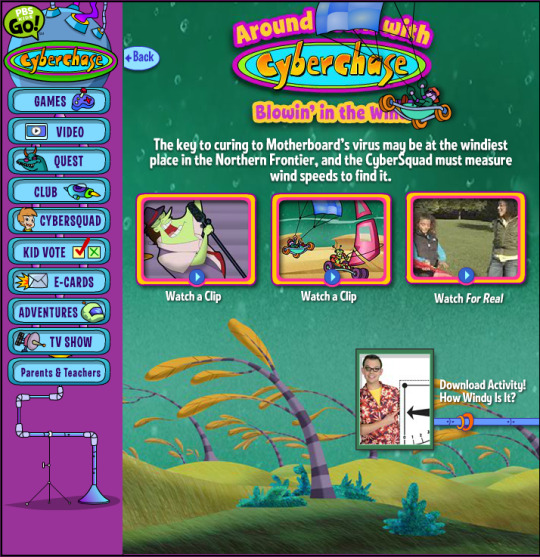
On the other hand, we have "The Harry Show". This was a live-action segment performed by Harry from "Cyberchase for Real". These were short segments when he discussed math topics. However, I believe these were exclusive to the website, and they were not aired on television like "Cyberchase for Real".
Here is the page showing the titles for the five episodes that were produced.
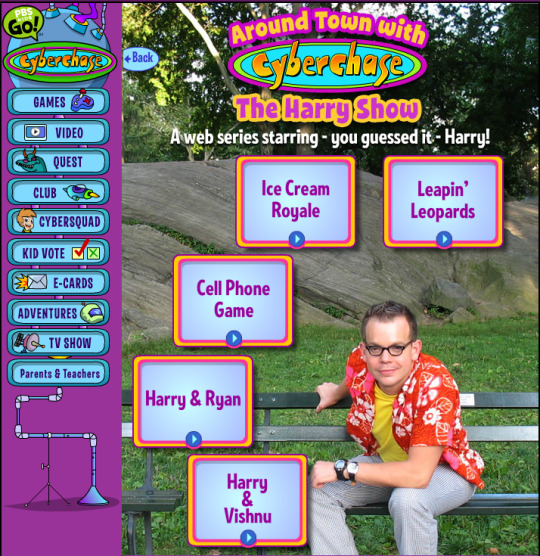
I won't reproduce them directly on this post. However, I will include links to the pbs.org website, which is hosting the videos almost 15 years later.
Leapin' Leopards: https://www.pbs.org/video/cyberchase-the-harry-show-leapin-leopards/
Ice Cream Royale: https://www.pbs.org/video/cyberchase-the-harry-show-ice-cream-royale/
Cell Phone Game: https://www.pbs.org/video/cyberchase-the-harry-show-cell-phone-game/
Math on the Street: Harry & Ryan: https://www.pbs.org/video/cyberchase-math-on-the-street-harry-ryan/
Math on the Street: Harry & Vishnu: https://www.pbs.org/video/cyberchase-math-on-the-street-harry-vishnu/
In case PBS ever decides that these old videos need to go, I put them on the Internet Archive as well: https://archive.org/details/leopards_202404
That's about it for this promotion.
#cyberchase#cartoon#2000s#nostalgia#pbs kids#2000s childhood#archived web content#flashpoint archive#longpost
2 notes
·
View notes
Text
According to a report published during 2017, Google accounts for more than 79% of all types of global desktop search traffic and it receives more than 63,000 searches per second throughout the world. However, with increasing awareness about the advantages of SEO strategy, an organization needs to engage top experts in order to take full benefits of online web traffic as they have in-depth experience in advanced SEO and would be able to make a real difference in your business. To accomplish this purpose, 10 SEO Experts you should be following to stay on top are as follows – Matt Cutts The first and foremost name in this context is Matt Cutts, the head of Google’s Webspam team. A go-to-guy when it comes to SEO, his main claim to fame remains 500 short videos that were created to offer SEO advice that ranges from SEO tools to e-commerce tips and also includes websites and other items. With these videos, he continues to encourage webmasters and business owners for improving the search rankings of their websites. Rand Fishkin The second name that is revered in this context is Rand Fishkin, co-founders of various sites such as Inbound.org and Moz. In addition, he is also the author of a famous book, “Art of SEO”. Even today, he provides extensive SEO advice through various forums and blog posts. In addition, he was the CEO from 2007-2013 and has presented his ideas on various platforms such as Stanford University, the United Nations, Facebook and Google. Neil Patel When it comes to IT field, who can forget the contribution of the Indian Neil Patel, the co-founder of QuickSprout, KISSmetrics and Crazy Egg; he is still a top name in SEO field. Today, according to Forbes, he is considered as one of the top 10 online marketers. Even today, he continues to offer his expertise on different websites and provides quality content. All you have to do is to search his name on the search engine and you can get access to his content . Bill Slawski The next name that has a prominent place in this list is Bill Slawski, who is currently the President of SEO by the Sea. Since 1996, he is working in the SEO field and has continued to improve SEO of various web pages and websites of many prominent organizations such as Comcast, Baltimore.org, The American Psychological Association, John Hopkins University, and Harvard Business School. Bruce Clay The fifth name in this list is of Bruce Clay, the current President and founder of BruceClay, Inc. a prominent digital marketing company located in various countries such as USA, Brazil, Japan, India and Switzerland. He has been working in this field since 1996. In addition, he has collaborated with others authors to write and publish an informative book, ‘Search Engine Optimization All-in-One for Dummies’. Even today, he continues to stay active by providing advice in this community. Eric Ward The next name in this prominent list is Eric Ward, who is a columnist at SearchEngineLand, SearchEngineWatch and ClickZ. Currently, he is also the President of EricWard.com. Working since 1994, Eric founded the web’s first services for linking, announcing and building buzz for various websites. In addition, he was the person who created and implemented the successful linking campaigns used for various websites such as Weather.com, Amazon.com Books, PBS.org, and the AMA. Further, he continues to speak at major SEO conferences and events. Dave Naylor The seventh name in this list should be of Dave Naylor, founder of Bronco who is working in the digital marketing industry since 1998. Since he found his company during 2003, he continues working with international brands. In addition, he has been a prominent speaker at various major conferences such as SMX, SES, iGaming Affiliate conferences since a decade. Andy Beal The eighth prominent name in this context is of Andy Beal, CEO, and founder of Trackur. In addition to that, he is also the author of the book, “Repped: 30 Days to a Better Online Reputation” and the founding editor of Marketing Pilgrim.
Unlike other top SEO experts, he specializes in online reputation management. In this capacity, he has worked with some premium brands such as Lowes, Motorola and NBC. Barry Schwartz The next name that can be placed in top ten SEO experts list is of Barry Schwartz, the founder of Search Engine Roundtable, and the current President and owner of RustyBrick, Inc. He is also the author of the book, “MarketingLand”. He continues to study the changes that come from the Google in SEO algorithm and offers a resolution for the benefit of the users. Danny Sullivan The last and final name that should be on this list is of Danny Sullivan who handles many responsibilities in various capacities such as Editor-in-Chief of SearchEngineLand. In addition, he also collaborates with Barry Schwartz for increasing knowledge related to SEO with Google. Further, he also continues to be forefront when there is any SEO conference, publication or new activities.
0 notes
Text
0 notes
Text
How to installation Pbs.org/activate
Enjoy full-duration episodes of nearby in addition to country wide PBS programming on streaming players. Without a cable or satellite TV for pc subscription, viewers get to watch brief clips and highlights of the content material. But prompt a compatible device alongside a pbs.org/activate account to free up all the movies.
Channel Subjects:-
· There are a few really antique and conventional TV series and a range of featured programming to select from beneath the ‘Featured Programs’ alternative.
�� Local affiliated gives and shows are to be had with an easy selection procedure from the affiliate station listing.
· The different alternatives that customers have are ‘Originals’ containing brief films, although now not full-duration TV indicates, these are fun internet episodes.

· Go to ‘Staff Picks’ to look at specific movies from a variety of other PBS suggests.
· On PBS, content is continuously renewed.
· The expiry of a specific series or programming can be visualized below the ‘Expiring Soon’ class.
· The channel does not require any linking nor does it invite any account introduction.
· But local PBS stations can speak all programming information and community updates through an e-mail deal with.
· Therefore, it's far advocated to create an account.
· PBS also updates individuals approximately their fund-raising initiatives.
1 note
·
View note
Link
#TV Activate#TV Activates#TV Activate Code#netflix.com/tv8#www.amazon.com/mytv#youtube.com/tv/activate#youtube.com/activate#xfinity.com/activate#pluto.tv/activate#showtimeanytime.com/activate#tubi.tv/activate#twitch.tv/activate#pbs.org/activate#nfl.com/activate#hbomax.com/tvsignin#nbc.com/activate#hulu.com/activate#espn.com/activate#disneyplus.com login/begin#disneyplus.com/begin#disneyplus.com/start#roku.com/linkcrunchyroll.com/activate#idgo.com/activate
1 note
·
View note
Link
PBS channel on Apple TV- Boon or Bane?
Well, recently the Telegraph posted in its news column stating that the PBS channel is a perfect rival to the BBC four. But, how on earth did this comparison came? The reason is said to be PBS’s move to include documentaries as part of its playlist.
The author of this article stated that PBS was a channel that didn’t have anything on its own and kept on borrowing content from the other platforms. Sigh! The channel was a good old weasel but it still managed to keep its turtle pace on track
Slowly, steadily a route has been made to the top. Read this article to know about activating the PBS channel on the Apple TV

Activation process
Apple TV has been an unlikely soul in the line of streaming boxes but it makes a difference when it comes to the interface and the content it delivers. Follow the steps below:
1. In the interface, search for the App store icon and find the PBS Video app
2. Then start the installation process by clicking the Add option
3. The PBS Video app shall show up along with the rest other platforms
4. After this, click the app with the remote to open it and proceed to the activation process
To perform the activation process, navigate to the pbs.org/activate using the web browser on your PC. Also enter the code that is provided by the Apple TV and also click continue in the final step. The platform gets activated in the end
Support
In case of any queries with the PBS channel activation you can visit pbskids.org/activate, or call the support team at +1-844-879-5200 and get the issues fixed soon!
0 notes
Text
Examining the history of queer comics in the US
As previously mentioned, I am interested in creating graphic novels or comics during my practice as an illustrator. As a Nigerian, I also wish to include Nigerian elements in my comics and social commentary about the state of my home country. I want to comment on the injustices being faced by minority groups in tasteful ways in both metaphorical - like some of my favorite superhero comics- and literal as comic journalism. A particular social injustice I am interested in that the Nigerian government seems unwilling to budge on is its treatment of LGBTQIA+ people.
Considering the laws set in place against LGBTQIA people in Nigeria, a graphic novel about the situation will be controversial. I am intrigued to research how entertainment media (specifically, comics) navigated representing queer issues and topics in other countries that previously had unfavorable laws and attitudes towards queer people but have changed over time
The focus for this post will be the United States of America with a look at the correlation between the developments in the representation of queerness in comics and other mass media and the change in the country’s attitudes towards queer people.
In 1954, major U.S. publishers formed the Comics Magazine Association of America and its censorship arm, the Comics Code Authority (CCA 1954). This has been said to be in response to concerns over the explicit violence and sexual themes in depictions of superheroes (Bramlett, Cook and Meskin, 2016). The sexual themes that seemed queer in these comics were largely sub-textual and highlight the prejudice and paranoia against queer possibilities like what the Nigerian government currently emulates. This act of censorship brought to a halt any subtle references to gender nonconformity and same-sex attraction in mainstream comics.
Because of the restrictions in mainstream publishing, queer comic strips started to appear in underground comics and adult magazines in the 1960s. Chute (2008) talks about the rise of underground comics during this period as a reaction to the censorious content code that debilitated the mainstream industry and describes them as an influential cultural vehicle, challenging and arresting because they meditated on the violation of taboo. According to Murphy (2014), the world’s first gay comic strip was arguably Harry Chess: That Man from A.U.N.T.I.E., (Fig. 01) published from 1965 to ’66. However, other scholars like McGurk (2018), have pointed out earlier presences of queer comics - even though subliminal- like Lucy and Sophie Say Goodbye (Fig. 02) which was published weekly in newspapers in 1905, written and drawn by an unidentified artist. In the same decade as Harry Chess, Tuoko Laaksonen illustrated and released another popular gay comic series titled 'Kake', under the pseudonym, Tom of Finland.
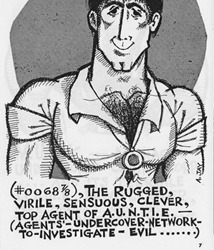
(Fig 01) Harry Chess That Man from A.U.N.T.I.E. https://glreview.org/article/the-lives-and-times-of-harry-chess/
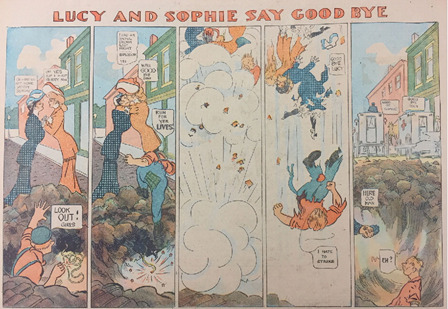
(Fig. 02) Lucy and Sophie Say Goodbye, May 21, 1905. Chicago Tribune.
Unlike Lucy and Sophie Say Goodbye, which could be interpreted as an exaggerated parody of women's social behavior, Harry Chess and Kake were inherently sexual and left little for subtext. Murphy (2014) describes the publication of Harry Chess as a key shift in gay publications and gay politics, and Ajuan Mance in The Routledge Companion to books noted that the explicit sex in strips of the two comics “created both a space and a demand for broader portrayals of gay men’s lives”. (Bramlett, Cook and Meskin, 2016).
To provide context for where the United States was in laws concerning queer rights in the ’60s, Illinois had just become the first U.S. state to decriminalize homosexuality by repealing its sodomy laws, and several milestone protests including the Stonewall Riot occurred during the decade The Supreme Court had also ruled in favor of an LGBT magazine when a suit was filed against them after the U.S. Postal Service and FBI declared the magazine obscene material. (Milestones in the American Gay Rights Movement | American Experience | PBS, 2021). There had been little progress in legal rights compared to the country’s present status, but queer Americans were visibly fighting for them.
The late 1970s and early 1980s saw the next wave of queer comics like Wendel, It’s a Gay Life, Leonard and Larry, Poppers and Chelsea Boys, which were all published in gay magazines. These comics reflected their primarily gay male readership in that the characters “attended gay pride celebrations, shopped at LGBTQ bookstores, and responded to the AIDS crisis, the Defense of Marriage Act (DOMA), and Don’t Ask/Don’t Tell, all while falling in and out of love.” (Bramlett, Cook and Meskin, 2016).
It was not until about 28 years later in Marvel’s Captain America Vol. 1 #270 (1982) that either of the large mainstream comics publishers (Marvel and DC) featured a story-line depicting queer or trans characters (Bramlett, Cook and Meskin, 2016). In this issue, Captain America helps his childhood best friend, Arnie, by rescuing Arnie’s close friend, Michael. Through subtext, it seemed to become clear to Captain America that Arnie and Michael were, in fact, a couple. (https://marvel.fandom.com/wiki/Captain_America_Vol_1_270).
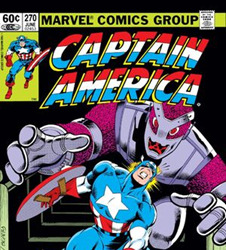
(Fig. 03) Cover of Marvel’s Captain America Vol. 1 #270 (1982)(https://marvel.fandom.com/wiki/Captain_America_Vol_1_270).
Throughout the 1980s, more queer characters were depicted, although indirectly and still with subtext like Captain America’s Arnie. The CCA, in response to the greater inclusion of LGBTQ characters and themes in the film and other popular media forms, revised its Code to lift its prohibitions against queer characters and content. CCA-approved comics however were to avoid the graphic depiction of “sexual activity” and that depictions of adult relationships, “be presented with good taste, sensitivity, and in a manner, which will be acceptable by a mass audience” (CCA 1989).
Over the years to date, DC and Marvel have introduced characters explicitly stating their orientation, including Northstar, an X-Men character; members of The Runaways and the Young Avengers; and notably Batwoman, who came out as a lesbian. The popular Archie Comics in 2010 introduced a gay character named Kevin Keller (Fig. 04) who eventually had his spinoff comic in 2012. Ajuan Mance noted the debut of Kevin Keller as queer attracted a higher level of attention than any Marvel or DC character (Bramlett, Cook and Meskin, 2016). In 2014, Kelvin Keller got married to his spouse in the Life with Archie series (Fig. 05) a few years after New York and other US states legalized same-sex marriage and a year before the Supreme Court declared same-sex marriage legal.
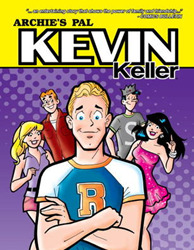
(Fig. 04) https://www.goodreads.com/book/show/11661956-kevin-keller
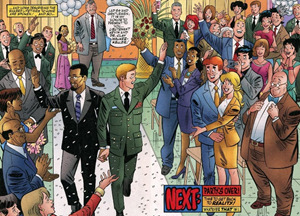
(Fig. 05) https://womenwriteaboutcomics.com/2019/06/the-wedding-issue-pride-edition-kevin-keller-and-clay-walker/
Taking this study for use in the Nigerian context can be applied in different ways. In the US, when the laws were restrictive and limiting towards queer content, the creators of comics and graphic novels under mainstream publishers had to operate in line with the laws. The creators could merely represent queer people through subtext. Unambiguous representation was only viewed through underground magazines from the ’60s up to the ’80s. In today’s age, Nigeria still has comparable, if not more regressive laws, but the Internet provides a similar and arguably better platform than the 20th century underground comics did.
The ease of access and ability to self-publish can cut out the publishing middleman, and I can illustrate distribute the stories I want via the Internet and social media platforms. Of course, if I am fortunate to secure a publishing deal for other ideas I have, I can employ subtext to include queer elements.
I will carry out more research on the best ways to present these proposed comics. Do I go in the explicit and sexually charged direction like Harry Chess and Kake to show a boldness and an unapologetic display of Nigerian queerness? Do I go the route of illustrating average Nigerian queer people to reflect their humanity hopefully to convince prejudiced people that queerness is not an abnormality? Or do I represent queerness in my comics for the Nigerian queer people to identify themselves in the media? These questions relate to the audience I want to reach because they will inform the content I want to create.
References
Bramlett, F., Cook, R. and Meskin, A., 2016, The Routledge Companion To Comics, Taylor & Francis Group.
Chute, H. 2008, "Comics as Literature? Reading Graphic Narrative", PMLA : Publications of the Modern Language Association of America, vol. 123, no. 2, pp. 452-465.
McGurk, C., 2018, Lovers, enemies, and friends: The complex and coded early history of lesbian comic strip characters, Journal of Lesbian Studies, 22:4, 336-353, DOI: 10.1080/10894160.2018.1449502
Murphy, M., 2014, The Lives and Times of Harry Chess, The Gay & Lesbian Review , 21(2): 22– 24.
Pbs.org. 2021. Milestones In The American Gay Rights Movement | American Experience | PBS. [online] Available at: <https://www.pbs.org/wgbh/americanexperience/features/stonewall-milestones-american-gay-rights-movement/> [Accessed 12 January 2021].
25 notes
·
View notes
Photo

OneNETnews EXCLUSIVE: PBS Kids' Arthur is Speaking Out with George Floyd's Death, under the Worldwide Issue of BLM
BOSTON, MASSACHUSETTS -- A year before the CoViD19 Pandemic in Wuhan, China... There's a newest short Public Service Announcement (PSA) straight from the PBS Kids at WGBH-TV 2: PBS Boston's original longest-running children's programming known as Arthur.
For those you don't know about Arthur from PBS Kids... A simplified explanation from the PBS website based from the About page:
"The chronicle adventures of Arthur Read is based on a children's books by the Author & Illustrator named Marc Brown, who has been working with the beloved Aardvark for over 4 decades. This was started in 1976, turned into the American-wide franchise before it goes worldwide. The viewing age target is aiming to 4-8 years old. His goal is to help foster an interest in reading and writing, to encourage positive social skills, and to model age-appropriate problem-solving strategies. It is originally produced by WGBH-TV 2: PBS Boston and animated by the Oasis Animation."
Arthur Read's house is located from the Elwood, Pennsylvania; under his own show with the same name for over 2 decades. His recent voice actor was named to Roman Lutterotti from 2019. But today, the death of George Floyd is in effect in selected countries worldwide from both North Carolina & Minnesota. The reason why before the worldwide protest starts, Black Lives Matter (BLM) will commence just a few weeks later after his death. You might remember with the non-protest person was arrested in Texas named Jose Martinez (known as BN_King, a former Brony media LIVE Streamer from Fort Worth city), after he was filmed for documenting his personal underground experience on foot (on our sister-affiliated station The Brony Network).
Today, he is now contacting from the video call by reaching out at home to Leah MacGrady, an oldest Lunch lady at the Lakewood Elementary School (LES), during the post-Pandemic of CoViD19 worldwide for the unfair issue of Black Lives Matter (BLM).
Arthur & Buster is speaking out publicly via Zoom by addressing this issue to OneNETnews, "I can't believe someone would be hurt like that, just because they're Black." He adds a response from Arthur... "Racism is so unfair. No one should ever judge someone by the color of their skin. I was talking to Mrs. (Leah) MacGrady the other day. She said there's a really long history of Black people not being treated fairly in this country."
Leah MacGardy was spoked to Arthur Read & Buster Baxter from home with the response of Black Lives Matter issue, "Well, Racism is like a Disease. If you don't treat it, it's just gonna get worse. It's about all of us. It's not enough to just say, I'm not racist, it's not my problem. We have to actively fight against racism. As my friend (John Lewis) once said... If you see something that is not right, not fair, not just, you have a moral obligation to do something about it".
She adds with the finale of response, "Talk about racism with your friends, your parents, your teachers. Don't be afraid to ask questions. We all have a lot to learn about this issue. Listen to people who have experienced racism firsthand. Imagine what it would be like if it happened to you or someone you love. And finally, act. When you see or hear of someone being treated unfairly, stand up for them, say something! It might be scary, but I guarantee you it's better for everyone. And it's the right thing to do."
At the end of the Public Service Announcement (PSA), the memoriam of John Lewis was reportedly died from the Pancreatic Cancer (known as the founding Father of Better America in the 5th District of Atlanta, Georgia from his hometown of Troy, Alabama). His battle was failed for 6 months but not for the CoViD19 post-Pandemic at the Civil Rights & Congress.
The Kapisanan ng mga Brodkaster ng Pilipinas (KBP) was possibly violating the free-to-air network of Public Broadcasting Service (PBS) if they air the Racism episode or the newest short of Arthur, under the Broadcast Code of the Philippines in 2007 with the referencing of Article 15: Section 4. There will be a fine on Television to PHP30,000 (U$D612). Additionally, it also applies to the Senate Bill #2814: Section 3.2 & 4b (Anti-Ethnic or Racial Profiling and Discrimination Act of 2011) with a sentence for a year, known as the Arresto Mayor with other fine of PHP100,000 (U$D2,100). PBS is on the crystal clear kid safe standards to prevent the racism episode or the short, excluding this Public Service Announcement (PSA).
Arthur has warned to the kids' viewers like you to stop this protest or the illegal activity of Black Lives Matter (BLM) for George Floyd. As always until then, it has to make a difference at all cost, during the post-Pandemic of CoViD19 worldwide; even for the bashers on social media themselves. Act responsibly if you can.
SOURCE: *https://pbs.org/parents/shows/arthur/about/ *https://en.wikipedia.org/wiki/Arthur_(season_23) *https://arthur.fandom.com/wiki/Elwood_City *https://arthur.fandom.com/wiki/Leah_MacGrady *https://wral.com/fbi-to-investigate-arrest-of-black-man-who-died-after-being-pinned-by-officer/19114480/ *https://wral.com/protests-over-death-of-george-floyd-end-in-fires-looting-property-damage-in-raleigh-and-fayetteville/19122800/ *https://en.wikipedia.org/wiki/John_Lewis *https://troymessenger.com/2020/07/17/john-lewis-lion-of-civil-rights-and-congress-dies-at-80/ *https://troymessenger.com/2020/07/30/lewis-mourned-as-founding-father-of-better-america/ *https://www.kbp.org.ph/wp-content/uploads/2011/07/2007-Broadcast-Code-Revised-June-15-2011.pdf and *http://www.senate.gov.ph/lisdata/112189539!.pdf
EXTREMELY HONEST DISCLAIMER: The views & opinions expressed from this news report are not those from the WGBH-TV: PBS in Boston. It does not clearly imitate this Police Suspect and/or the kids' programme in any matter of tolerance. Furthermore, the assumption for this news report will NOT state, intervene or reflect those of our news reporters. The station, management, interwebs and the network. Thanks for reading everypony...
-- OneNETnews Team
#international news#boston#massachusetts#elwood#pennsylvania#arthur read#buster baxter#arthur#pbs kids#blm#black lives matter#leah macgardy#zoom#george floyd#protest#worldwide#CoViD19#pandemic#OneNETnews
2 notes
·
View notes
Video
tumblr
NATIVE AMERICA - Groundbreaking New Doc Series Combines Modern Science and Scholarship with Native American Traditions and Oral History to Bring to Life the World Created by America’s First Peoples [ All Episodes Streaming For Free PBS.org! ]
“Weaving history and science with living indigenous traditions, the series brings to life a land of massive cities connected by social networks spanning two continents, with unique and sophisticated systems of science, art and writing.
Made with the active participation of Native American communities and filmed in some of the most spectacular locations in the hemisphere, NATIVE AMERICA reveals an ancient and still thriving culture whose splendor and ingenuity is only now beginning to be fully understood and appreciated. [...]
Narrated by Robbie Robertson (Mohawk and member of the famed rock group The Band), each hour of NATIVE AMERICA explores Great Nations and reveals cities, sacred stories and history long hidden in plain sight. [...]
Inventive animations by Academy Award-nominated artists and 3D computer modeling bring ancient ruins to life, enabling viewers to experience the pre-Columbian world in an immersive way. The result is a new window into a 15,000-year-old story that unifies North and South America and resonates to this day.” [source]
I AM SO EXCITED FOR THIS!! WATCH THE TRAILER!!! 4 episodes have aired so far and you can watch them on the link above! Aho!!!!!
#ndn#native american#indigenous pride#first nations#native#ive been waiting for this i totally forgot it was airing soon!!!#omg im so excite#LOOK AT THE TRAILER#LOOK AT THE ANIMATION#LOOK AT THE INDIGENOUS FOLKS IN CONTROL OF THEIR STORY#im so happy!!!!#happy native heritage month!!
2K notes
·
View notes
Text
The Second Slavery: How the Democratic North Kept Their Foot on Your Neck
Our nation has erupted in days-long protest, sparked by the murder of George Floyd by four Minneapolis police officers. Cities across the U.S., and even across the world have taken to the streets to make their voices heard. Some of the most violent clashes between protestors and police have happened in Brooklyn, Los Angeles and Atlanta where we saw two college students being pulled from their vehicle and attacked by police. What also can’t be ignored is the systematic lockdowns of cities where mayors along with local law enforcement have declared citywide curfews, oftentimes making these announcements within minutes of said curfews expiring. Chicago has even taken to shutting off their CTA public transportation, which left many essential workers and protestors stranded on the evening of May 31, 2020. Speaking of, May 31st is the anniversary of the bombing of Black Wall Street in Tulsa, Oklahoma which took place in 1921. As we commemorate the 99 year anniversary of the bombing of Black Wall Street where a town of successful Black families and businesses were not only terrorized but ultimately destroyed, Black people in America must dissect and investigate the other foot on their collective necks - the collusion of our government, politicians, and police organizations with immigrant populations enabling them establish wealth in the same way as our country’s forefathers - on the backs of Black people.
The south has an overt and often open racist history that has been on display for centuries, along with the legacy of slavery. The North, however, in places like Boston, New York City, Chicago, Philadelphia and many other cities is where the mob and mafia organized crime ran rampant and were also integral in institutionalizing racism against Black Americans. These same machines created unions that were politically connected to the Democratic party who aided and abetted in the financial rape of the African American community by denying them union jobs, adequate housing and worked with the police unions to keep Blacks ‘in line’. Jimmy Hoffa’s Teamsters routinely provided interest free loans to the Mafia. The movie Harlem Nights depicts many of how this was orchestrated, including purposely inundating Black neighborhoods with illegal activities such a prostitution and gambling, typically for about a period of 5 years or so before having massive raids to take down Black crime bosses, only then to evict the residents so that White immigrant populations could come in and buy cheap real estate that would almost always skyrocket in value. These same immigrants came to despise and discriminate against the very African Americans who made it possible for them to come to this country.
It’s kind of disheartening to see the lengths that Ray, Quick, and their circle have to go because a White criminal, who has a dirty detective on his side, wants a piece of their pie.
(nerdist)
The Immigration Act of 1965 was a direct result of the Civil Rights movement organized and executed by Black / African Americans - “Over the next four decades, the policies put into effect in 1965 would greatly change the demographic makeup of the American population, as immigrants entering the United States under the new legislation came increasingly from countries in Asia, Africa and Latin America, as opposed to Europe.” This facilitated the acceptance of many immigrants of color to the United States. Once on these shores, parents of immigrant children often discouraged their children fraternizing, emulating or dating African Americans.
https://twitter.com/keilahhhjd/status/1267199334296109056?s=21
In addition, almost all of these immigrant groups profited from the same types of organized crime that had benefited their white immigrant predecessors such as the Irish, Italians, Russians and many more of European origin. Money laundering, bootlegging, prostitution and many other illegal activities directly funded many of what are now established businesses, suburban enclaves full of homes and lifestyles that their descendants enjoy. The origins of the Mob in America can be traced to the urban ghettos of the late 19th century where Irish, Italian and Eastern European Jewish immigrants struggled to survive amid poverty, overcrowding and discrimination. These immigrants could get only the most dangerous and low-paying jobs (source: themobmuseum.org). The movie, Gangs of New York depicts much of this history, “The Irish Bowery Boys soon formed in a nearby area known as the Bowery. Battles between the Bowery Boys and Dead Rabbits (claiming more than 1,000 members each) were legendary, each of which was supported by smaller gangs they had spawned...Shrewd politicians immediately recognized the potential asset that the street gangs might represent. In the early 1830’s, several politicians (ward and district leaders) bought grocery stores in Five Points and the saloons and dance halls in the Bowery, the gathering places for the gangs. In return for their assured protection of the gangs’ meeting places, and financial rewards offered to the gangs for their loyalty, gang leaders returned the favor by taking care of jobs like blackjacking political opponents and scaring unsupporting voters away from the polls” (source: sagepub.com).
Philadelphia and Boston could also lay claim to having substantial street gangs before the Civil War; [sic] Philadelphia’s Public Ledger identified nearly 50 Philadelphia gangs between 1840 and 1870. These gangs persisted; a New York Tribune reporter described the northern suburbs of Philly in 1948 and 1949 as swarming with gangs.
“If any nationality has been linked to organized crime in the UnitedStates over the years, it would have to be Italian-Americans, at least in popular perception...countless books, movies and TV shows, from The Godfather right up to the Sopranos, the image of the Mafioso has become synonymous with the face of gangsters in America.” However, the Irish Mob began as penniless immigrants in the mid-19th century battled their way to power and established the first crime syndicate in America, which lasted for at least 150 years (source: toledoblade.com). The first gang leader from the streets to achieve prominence was John Old Smoke Morrisey, who ran gambling joints, saloons, and brothels in New York City, ultimately aligning himself with Tammany Hall, the city’s corrupt Democratic political machine. Of course the best known Irish (democratic) family is the Kennedy clan. Boston native Joseph P. Kennedy, father of JFK and Robert Kennedy was a bootlegger during Prohibition who supplied liquor to a rogue gallery of crime bosses, including Al Capone. During his son’s presidential campaign, Joe reached out to mobsters for help and Sam Giancana, then the Mafia boss of Chicago, delivered the state of Illinois for JFK, helping provide his winning margin in the 1960 election. Decades later, the Russian mob, Colombians and Latin Americans became the face of organized crime in America.
While the Italian mafia was the largest and most powerful, other ethnic groups also had organized crime rings. On the west coast, especially there are Asian American gangs as well. In Koreatown in L.A. for example, the original gangs first came from Korea, and flourished by being involved in illegal activities such as drug dealing, organized crime, money laundering and prostitution. Since the liberalization of the immigration laws of 1965, Chinatowns in the U.S. have experienced a consistent increase in their crime rates.
You will often hear the children and grandchildren and great grandchildren angrily tweet or disclaim aloud that their parents came to America AFTER slavery and that they “worked hard” to achieve financial and business success, therefore the idea of reparations is absurd and Black folks in America should follow suit and “work hard” as well. What’s so interesting is that all of this history of the corruption among immigrant organized crime and their collusion with politicians, government and law enforcement is not only documented but glorified in history, film and ironically rap music. Most recently one only has to look to last year’s The Irishman starring Robert DeNiro and Joe Pesce. The mob museum is literally an entire museum celebrating how these groups came to America, created a crime syndicate and created generational wealth, all while local politicians and police chiefs winked, shook hands, quietly collected their cut on their way to vacation in Miami with their families. These are the same cops with their foot on the necks of George Floyd, the same system that gave Jacob the Jeweler 2.5 years and a $50,000 fine while the BMF crime family serves 30+ years in prison. Who is really being protected and served?
We encourage all of you, especially those that live in major cities across the U.S. to do your own research of the history of organized crime and cross reference wealth and ownership of land and businesses in those same cities. It is only then that you will truly connect the dots, especially as you fully realize how those actions contribute to denial of home loans, redlining, poorly performing school districts etc. It was just prior to the murder of George Floyd gripping the nation that we were largely discussing the upcoming presidential election, an ornery white woman in Central Park. The south’s history of slavery, terrorism at the hands of the KKK and segregation are well documented, but the largely Democratic stronghold of the North has produced structural racism that is just as sinister if not worse. In the words of Joe Biden, “You Ain’t Black” if you don’t comprehend the second slavery created by the North which has largely contributed the conditions we now find ourselves in.
Other sources: csun.edu, repository.upenn.edu, pbs.org, wikipedia
#bmf crime family#george floyd#amy cooper#blm#black lives matter#the irishman#gangs of new york#protests#looting#joe biden#donald trump#black wall st#ados#fba#african americans
1 note
·
View note
Text
Activate Pbs channel for free on Roku
Never miss the full-length episodes of PBS shows. Among the top free channels on Roku, PBS channel is all-time favorite for Kids and Parents
It’s the page Pbs.org/activate that we prefer for activation. Let us explore more about the channel and top shows to watch

Is PBS channel free on Roku?
The answer is yes.
As no activation charges are required, viewers opt for it
Let us start to activate the most entertaining free channel
Are you interested to activate the channel?
Visit the channel store category, Movies, and TV and then begin your channel search
Now add the PBS channel & go to the page Pbs.org/activate
You will now receive a prompt to enter the channel activation code
As soon as you type the code, proceed with the onscreen guide to complete the activation process
Start watching the most popular PBS shows and the latest collections include Doctor Who, Independent Lens, The mind of a Chef, PBS news hour and lot more
Let us proceed with the PBS channel activation
All you need to do is to move to channel store category, Movies, and TV. The next step is to tap on the Add channel tab
Search for the channel icon on your device and click on it
Suppose if the added channel is not visible, it’s time to perform a system update
If you end up with issues
Use the valid page Pbs.org/activate
Make sure that you enter the valid PBS channel activation code
Device restart or reset can also help to avoid errors
If you need any assistance while activating pbs channel on roku .reach us at our toll-free number +1-844-576-1390
1 note
·
View note